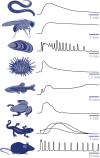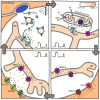Modulators of calcium signalling at fertilization
- PMID: 32673518
- PMCID: PMC7574550
- DOI: 10.1098/rsob.200118
Modulators of calcium signalling at fertilization
Abstract
Calcium (Ca2+) signals initiate egg activation across the animal kingdom and in at least some plants. These signals are crucial for the success of development and, in the case of mammals, health of the offspring. The mechanisms associated with fertilization that trigger these signals and the molecules that regulate their characteristic patterns vary widely. With few exceptions, a major contributor to fertilization-induced elevation in cytoplasmic Ca2+ is release from endoplasmic reticulum stores through the IP3 receptor. In some cases, Ca2+ influx from the extracellular space and/or release from alternative intracellular stores contribute to the rise in cytoplasmic Ca2+. Following the Ca2+ rise, the reuptake of Ca2+ into intracellular stores or efflux of Ca2+ out of the egg drive the return of cytoplasmic Ca2+ back to baseline levels. The molecular mediators of these Ca2+ fluxes in different organisms include Ca2+ release channels, uptake channels, exchangers and pumps. The functions of these mediators are regulated by their particular activating mechanisms but also by alterations in their expression and spatial organization. We discuss here the molecular basis for modulation of Ca2+ signalling at fertilization, highlighting differences across several animal phyla, and we mention key areas where questions remain.
Keywords: calcium channels; calcium signalling; egg activation; fertilization; oocyte.
Conflict of interest statement
We declare we have no competing interests.
Figures





References
-
- Lillie F. 1919. Problems of fertilization. Chicago, IL: University of Chicago Press.
-
- Dalcq A. 1928. Le rôle du calcium et du potassium dans l'entrée en maturation de l'oeuf de pholade (Barnea candida). Protoplasma 4, 18–44. (10.1007/BF01607955) - DOI
Publication types
MeSH terms
Substances
Grants and funding
LinkOut - more resources
Full Text Sources
Miscellaneous

